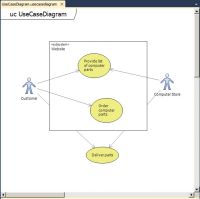Inside VSTS
Visual Studio 2010: Introduction To The New Architecture Tools
Mickey provides an introduction to the new architecture tools in Visual Studio 2010 Ultimate.
TAG: Mickey gives you a introduction to the new architecture tools in Visual Studio 2010 Ultimate
Visual Studio 2010 - Introduction To The New Architecture Tools
The architecture tools in Visual Studio 2010 have undergone a radical transformation. Support for Unified Modeling Language 2.1.1 (UML) diagrams has been added, as well as new tools and diagrams to help you understand your application, such as the Architecture Explorer and Dependency Graphs. In this column we are going to provide a brief overview of new functionality in Visual Studio 2010 that will be of interest to software architects. Future columns will delve into each of these individually in more detail.
To create the following UML diagrams, as well as to use the Architecture Explorer, requires Visual Studio 2010 Ultimate. Users of Visual Studio 2010 Premium have the ability to read diagrams created in Visual Studio 2010 Ultimate.
UML Diagrams in Visual Studio 2010
Out of the box, Visual Studio 2010 supports the following UML diagrams:
-
Use Case Diagrams
- Activity Diagrams
- Sequence Diagrams
- Component Diagrams
- Class Diagrams
A use case diagram provides a summary of who is using the application, and how they plan on using it. It is used to provide a view into how the application will be used and the actions that can take place in the system. Figure 1 shows an example of a use case diagram in Visual Studio 2010.

[Click on image for larger view.] |
| Figure 1.A use case diagram in Visual Studio 2010. |
Once you have developed your use case diagrams, you will want to break them down into activity diagrams. An activity diagram is used to show a software process or business activity as a workflow through a series of actions. Figure 2 shows an example of an activity diagram in Visual Studio 2010.
Sequence diagrams are used to show interactions between different objects in the software system. Usually these interactions take place as a series of messages exchanged between the different objects. Figure 3 shows an example of a sequence diagram in Visual Studio 2010.
Once you have created your use case, activity and sequence diagrams, you are ready to visualize the different components that make up your software system. Component diagrams enable you to do just that, by laying out the different components in your system, and how they interact. Figure 4 shows an example of a component diagram in Visual Studio 2010.
Class diagrams (also referred to as logical class diagrams) are used to describe the different objects in the application being developed. It does this without any reference to how the objects are implemented, allowing the diagram to be used regardless of the underlying code base used to develop the system. Figure 5 shows an example of a class diagram.
Other Architecture Tools in Visual Studio 2010
In addition to UML support, Visual Studio 2010 also provides extra tools to help architects and other project team members understand the system under development. These tools include:
-
Layer Diagrams
- The Architecture Explorer
- Dependency Graphs
Layer diagrams are a new type of diagram that allow you to describe the "logical" architecture of your application. Your code can be organized into different "layers", allowing a better understanding of what objects perform what tasks. Layer diagrams can also be incorporated into the automated build process, allowing you to ensure that no architectural constraints have been violated. Figure 6 shows an example of a layer diagram.
The Architecture Explorer is a tool available in Visual Studio 2010 Ultimate that allows you to drill down into an existing code base, or even into compiled managed code, to gain a better understanding of what the code is trying to accomplish. Figure 7 shows an example of the Architecture Explorer.
The Architecture Explorer can be combined with dependency graphs to make it easy to understand your code base. Dependency graphs are used to show the relationships between different objects and areas of code. Information discovered using the Architecture Explorer can be easily visualized using dependency graphs. Figure 8 shows an example of dependency graph created using information from the Architecture Explorer.
Conclusion
Visual Studio 2010 Ultimate contains several new tools of interest to software architects. Its support of UML 2.1.1 diagrams, as well as the new tools in the Architecture Explorer and dependency graphs, provides needed functionality that allows architects to design the applications they want, and help developers better understand the software that needs to be built.
About the Author
Mickey Gousset spends his days as a principal consultant for Infront Consulting Group. Gousset is lead author of "Professional Application Lifecycle Management with Visual Studio 2012" (Wrox, 2012) and frequents the speaker circuit singing the praises of ALM and DevOps. He also blogs at ALM Rocks!. Gousset is one of the original Team System/ALM MVPs and has held the award since 2005.